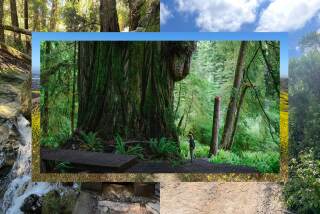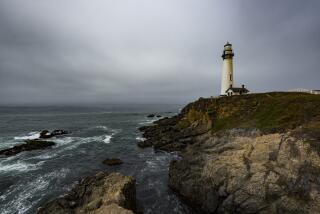A National Park Less Traveled
Sometimes it seems that North Cascades National Park, about 90 miles northeast of Seattle, has more glaciers than visitors.
OK, so I’m exaggerating a little. But the park, home to 318 glaciers (half the total number in the continental United States), attracts only about 20,000 visitors a year. Compare this number with the nearly 2 million a year who flock to Mt. Rainier, then consider that some officials consider any park with fewer than 500,000 visits to be “lightly visited.”
Many park features, obviously named by tell-it-like-it-is early explorers and climbers, not chambers of commerce and visitor bureaus, do not, in truth, entice most visitors: Damnation Peak, Desolation Peak, Forbidden Peak, Ragged Ridge and Mt. Terror.
It’s certainly not for lack of scenery that people stay away from North Cascades National Park in droves. The park is a collection of snow-capped “American Alps,” deep valleys, alpine lakes and thick forests.
Even if the number of visitors should unexpectedly rise, there is plenty of room to roam in the park’s half-million acres of wilderness. And the park is linked with Lake Chelan and Ross Lake national recreation areas to make up the North Cascades Complex. The two large lakes, also under National Park Service dominion, plus surrounding National Forest wilderness, add up to a vast tract that would take a lifetime to explore.
Learning that the national park has about 400 miles of maintained trail can make a hiker’s heart flutter in expectation. However, many park trails are very long, suitable only for multi-day backpacking expeditions. Much of the park’s vast high country is accessible only by cross-country travel. Relatively few trail heads can be found along North Cascades Highway, the region’s only paved road.
The park’s peaks and passes offer glorious views and are well worth the considerable effort required to ascend them. One of my favorite Cascade hikes is the ascent of Cascade Pass.
How many switchbacks climb to the top of Cascade Pass?
Don’t ask.
How’s the view from up there?
Stupendous, in a word.
Hanging glaciers, high cliffs, a horizon of jagged peaks--the views from Cascade Pass and from farther along the crest at Sahale Arm are, in the opinion of many veteran Cascades hikers, among the best in the Pacific Northwest.
North Cascades Highway may very well live up to its hype as Washington’s most scenic drive; however, while the drive may be one you’ll long remember, this hike is one you’ll never forget. In fact, even the trail head parking lot boasts eye-popping vistas of glaciered mountains--a view better than any other available to the motorist.
The hike to 5,423-foot Cascade Pass is a popular one, particularly among weekend warriors from Seattle but increasingly among out-of-state and foreign hikers. What was once a rugged route used by Native Americans and later by explorers and settlers has now, after much National Park Service engineering, been rendered into a well-graded, wide pathway with a multitude of switchbacks. Experienced hikers accustomed to much steeper Cascade climbs feel slowed to a slug’s pace by the zigzagging, but more casual hikers are grateful for the user-friendly design.
By North Cascade National Park standards, this trail is fairly well traveled. Don’t be surprised if you find a dozen hikers on the pass when you surmount that last switchback. Truly, the National Park Service has thought of everything you might use: Note the self-composting toilet perched atop Cascade Pass.
The first two miles of trail gently switchback through the forest, then steepen as more switchbacks take you above timberline to open, lily-bedecked meadows that offer increasingly good views.
Not as good as those from Cascade Pass, however. It’s the greatest show on ice--Cascade Peak, the Triplets and the sometimes show-stopping performance of Johannesburg Mountain, whose hunks of glacial ice tumble from its shoulders to explode on the rocks below.
Access: From Washington 20 in Marblemount, turn east on Cascade River Road (rather rough dirt) and follow it 22.3 miles to road’s end and the trail head.
(BEGIN TEXT OF INFOBOX / INFOGRAPHIC)
Cascade Pass Trail
WHERE: North Cascades National Park
DISTANCE: To Cascade Pass is 71/2 miles round trip with 1,800-foot elevation gain.
TERRAIN: Glaciers, high peaks and passes.
HIGHLIGHTS: Rarely visited national park, stunning high country.
DEGREE OF DIFFICULTY: Fairly strenuous.
FOR MORE INFORMATION: North Cascades National Park, Sedro Woolley, WA 98284; tel. (206) 856-5700.
More to Read
Sign up for The Wild
We’ll help you find the best places to hike, bike and run, as well as the perfect silent spots for meditation and yoga.
You may occasionally receive promotional content from the Los Angeles Times.






